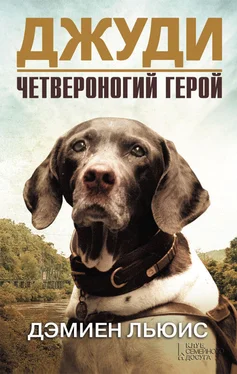Фрэнк объявил награду в пятьсот шиллингов (поистине огромные деньги для Танзании) за возвращение Джуди и разослал это сообщение по всем окрестным деревням. По истечении трех дней новостей по-прежнему не было. Фрэнк был в отчаянии, когда на четвертый день пришел Абдулла и сказал, что нашел собаку. Фрэнк и Абдулла запрыгнули в джип — дорогу показывал местный житель.
Вождь деревни повел их в хижину. Он открыл дверь, и Фрэнк увидел Джуди. Она выглядела невероятно изможденной: едва могла стоять. При виде Фрэнка собака приподнялась на ноги, помахала хвостом и вновь упала. Ее завернули в одеяло и отвезли домой. Из ее тела удалили сотни клещей, промыли раны и продезинфицировали их. Джуди поела, после чего ей вроде бы стало лучше и она провалилась в глубокий сон. Дни шли, она становилась бодрее, и Фрэнк решил, что все худшее уже позади. Но в ночь на 16 февраля Джуди вдруг начала стонать и скулить. Фрэнк сидел с ней в темноте. Она то и дело просыпалась, продолжая скулить, видимо от боли. К рассвету она не в состоянии была встать и явно чувствовала себя очень плохо.
Фрэнк нес ее по улицам Начингвы в госпиталь, у него на руках она по-прежнему жалобно скулила. Доктор Дженкинс, английский хирург, обнаружил у собаки опухоль молочной железы и немедленно ее прооперировал. Поначалу казалось, что операция прошла хорошо. Однако спустя несколько часов стало понятно, что собака, которая пережила столько опасностей, стала жертвой столбняка.
Она по-прежнему пыталась бороться, ей было больно. Для хирурга было очевидно, что она скоро умрет.
— Позвольте мне прекратить ее муки, Фрэнк, — тихо сказал он.
Тот кивнул в знак согласия. 17 февраля 1950 года в пять часов вечера по танзанийскому времени Джуди не стало.
Ее тело завернули в униформу военно-воздушных сил (та была подарена ей как талисману ВВС) и положили в маленький деревянный гроб. Джуди похоронили неподалеку от их жилища в Начингве. Фрэнк и его рабочие соорудили из белого камня и поставили на могиле памятник с металлической табличкой. На ней написано следующее:
В память о Джуди — обладательнице медали Марии Дикин.
Собака породы английский пойнтер.
Родилась в Шанхае в 1936 году — умерла в феврале 1950 года.
14 февраля 1942 года была ранена во время бомбардировки судна Королевского флота «Кузнечик» и едва не утонула близ островов Лингга.
26 июня 1943 года стала жертвой крушения судна «Van Waerwijck» в Малаккском проливе.
Находилась в японском лагере для военнопленных с марта 1942 года по август 1945 года.
Китай, Цейлон, Ява, Британия, Египет, Бирма, Сингапур, Малайя, Суматра, Восточная Африка.
Вечная память героям!
Краткая библиография
Ambushed Under The Southern Cross — The Making of an American Merchant Marine Officer and His Ensuing Saga of Courage and Survival, Capt. George W. Duffy. An American merchant navy Captain’s memoir of his ship being sunk by a German raider and the Japanese POW camps spread over Java, Singapore and Sumatra that he survived.
Beyond the Bamboo Screen — Scottish Prisoners of War Under the Japanese, Tom McGowran, OBE. A compilation of articles and stories from the Scottish Far East Prisoner of War Association.
Escape to Captivity, Peter Hartley. The story of a young Sergeant in the British Army who refuses to surrender at Singapore, and ends up being captured by the Japanese and imprisoned on Sumatra.
Marines Don’t Hold Their Horses, Ian Skidmore. The story of Colonel Alan Warren, CBE, DSC, who having helped many escape the Japanese via Sumatra ended up as a prisoner of war himself.
Prisoner in Nippon, Ray S. Stubbs. Tells the story of the author’s retreat from Singapore and capture by the Japanese and the years he spent as a prisoner of war.
Prisoners in Java — Accounts by Allied Prisoners of War in the Far East (1942–1945) captured in Java. As the title suggests, the book contains collected articles written by former POWs, compiled by the Java Far East Prisoner of War Club.
Prisoners of War — Australians Under Nippon, Hank Nelson. Stories of the Australian servicemen and women held in Japanese prisoner of war camps.
Spice Island Slaves, Leslie J. Audus. Presents a history of the Japanese prisoner of war camps in Eastern Indonesia during the war years.
Survivors of the Sword — Prisoners of the Japanese 1942—45, Brian MacArthur. Compelling stories from survivors from across the Japanese prisoner of war and slave-labourcamps. An excellent read.
The Animal Victoria Cross — the Dickin Medal, Peter Hawthorne. Compilation of short stories covering the Dickin Medal winners throughout its history. 4386.indd 320 26/02/14 7:30 PM
The Animals’ VC — For Gallantry or Devotion, David Long. Compilation of short stories covering the Dickin Medal winners throughout its history.
The Conjurer on the Kwai: Captivity, slavery and survival as a Far East POW, Peter Fyans. Superb first-hand account of a British POW who used his skills as a magician and conjurer to stay alive in the Japanese labour camps, and to save countless other Allied lives.
The Defining Years of the Dutch East Indies, 1942–1949, edited by Jan A. Krancher. Contains survivors’ accounts of the Japanese invasion of what was then the Dutch East Indies and the incarceration of the European, American and local POWs and their forced labour on the death railway.
The Judy Story, E. Varley. A short but engaging book written with the assistance of some of the Yangtze gunboat crews, telling of Judy’s life and adventures.
The Jungle Journal — Prisoner of the Japanese in Java 1942—45, Frank and Ronald Williams. The story of a young Royal Artillery officer who was held as a Japanese prisoner of war in the Dutch East Indies, as told through his diaries.
Читать дальше
Конец ознакомительного отрывка
Купить книгу











